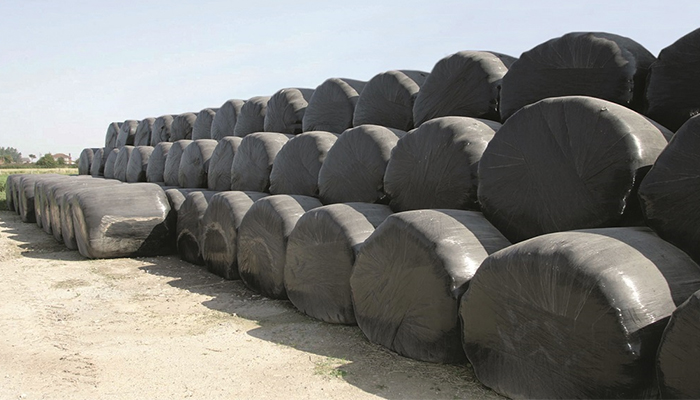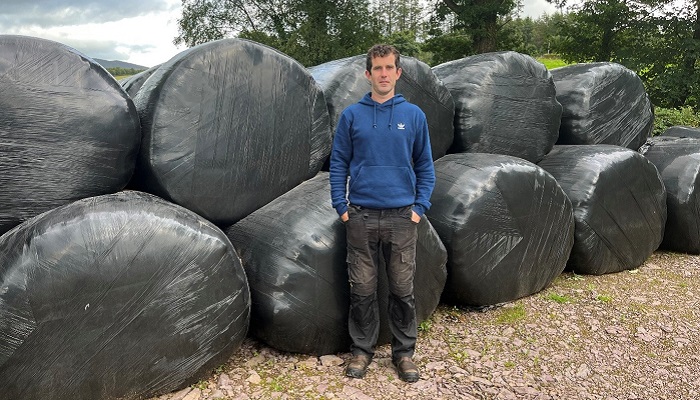02 August 2023
Winter fodder situation on DairyBeef 500 farms

The dry spell in late May / early June affected participating farmers in the DairyBeef 500 Campaign across the country very differently, explains Gordon Peppard, DairyBeef 500 Advisor.
Farmers in the north west and west saw little or no effect of the dry weather, whereas the farmers in the east, south east and south suffered varying degrees of drought conditions for a number of weeks.
Remedial action had to be taken in many cases by introducing silage and concentrates to animals at grass to get over the grass deficit for a few weeks. This all has had a knock on effect. In some cases, winter silage stocks have been reduced, the opportunity to plan for second cut silage has not gone to plan and the removal of surplus grass from paddocks as quality silage bales has not happened as expected.
It is essential that all farmers assess their fodder stocks for the winter and complete a fodder budget. If there is a shortfall arising, it is very important to take action as soon as possible.
Firstly, every farmer needs to know how much fodder they require for the upcoming winter period. With the changing weather patterns, it is also advisable to build up at least a 20% buffer to cover an extra-long winter due to bad weather resulting in early housing or late turn out to grass in the spring, or to cover droughts or wet spells after animal turnout next spring / early summer, as these periods are becoming more regular and causing silage to be fed in periods not usually associated with winter feeding.
Below is an example of a fodder budget for Shane Cranny, one of fifteen participating farmers in the Teagasc DairyBeef 500 Campaign. Shane is farming close to Myshall, Co. Carlow, one of the areas worst affected by the recent dry spell.
How much silage does Shane need?
Shane reared 110 calves last Autumn (2022) and these animals are now to be wintered as yearlings. Most of the 2021-reared autumn steers will be sold off of grass before the second winter. The last 10 two year old steers will still be on the farm and will be wintered until December/January, where they will be finished out of the shed.
Table 1: Silage requirements on Shane Cranny’s farm (excluding concentrate)
| Animal type | No. of stock | Feeding months | Pit silage per month (tonnes) | Total (tonnes) |
|---|---|---|---|---|
| Two year old steers | 10 | 3 | 1.3 | 39 |
| Yearling steers | 110 | 4.5 | 1 | 495 |
| Total | 534 | |||
| Plus 20% buffer | 640 |
In the above scenario, Shane would require approx. 640 tonnes of silage for the winter (includes 20% buffer), this figure assumes only silage fed and no concentrate supplementation.
A decision on how much concentrates to feed will be determined by silage quality (testing silage in early September) with a target to have all yearling animals gaining a minimum of 0.6kg average daily gain over the winter period.
In reality, a minimum of 1-1.5kg of concentrates per animal will probably be fed over the winter to the yearlings and the remaining two year olds will be finished out of the shed on approx. 5-7kg of concentrate. Therefore, if the yearlings receive 1.5kg of meal for four months, allowing concentrates to be removed from the diet for the two weeks before turnout, we have 110 animals x 120 days x 1.5kg per day = 19,800kg. Every one kg of concentrate fed will reduce the silage requirement by 4-5kg. Therefore, 19,800kg x 4 = 79,200kg (79t) (fresh weight) of silage saved.
Calculating Shane’s feed supply
There were 25 bales left over from the winter of 2022. Shane harvested 326 bales from his first cut in May and bought 71 bales in June. During the drought period, 70 of these bales were used to supplement stock at grass. Second-cut silage and paddock bales in July yielded another 140 and 76 bales, respectively.
| Feed type | Month | No. of bales | Conversion to tonnes factor | Total (tonnes) |
|---|---|---|---|---|
| 2022 silage | Leftover | 25 | 0.9 | 23 |
| First cut | May | 326 | 0.9 | 293 |
| Bales used during drought | June | 70 | 0.9 | -63 |
| Bought bales | June | 71 | 0.9 | 64 |
| Second cut | July | 140 | 0.9 | 126 |
| Paddock bales | July | 76 | 0.9 | 68 |
| Total | 511 |
The plan over the next two months is that as paddocks become too strong for grazing, they will be removed as surplus bales. With a number of the two year old steers now on a finishing programme to have them slaughtered before the start of the 2023 winter, the pressure should be taken off the grazing area and the opportunity for surplus bales should be an achievable target.
Therefore, as things stand the total demand is for 640t of silage and the current supply is 511t. Currently Shane`s scenario means that he will require an additional 143 bales (640 minus 511 = 129/0.9 = 143) to meet his demand and to provide a buffer. To bridge this shortfall, there are a number of options that Shane and other farmers in the same situation can do, these are outlined below.

Shane Cranny pictured on his farm in Myshall, Co. Carlow
Options if short of winter feed
Firstly, there is no single strategy to deal with a fodder shortage. A combination of actions can be undertaken. The important thing is to take action as soon as possible. The options include:
- Reduce feed demand by offloading stock. Sell some weanlings/stores/culls in the autumn. This is not an option for Shane as he is trying to build and retain stock numbers to increase output on the farm. Also he will have a lot of grassland to graze next spring and reducing numbers now that are destined for spring grazing will only cause further problems next spring.
- Feed additional meal to weanlings over the winter. Depending on the cost of alternative fodder this may be an option for some farmers. It is essential to ensure that stock meet their targets of 0.6kg average daily gain over the winter period. Depending on silage results, additional concentrates maybe required to meet this targeted average daily gain.
- Maximise grass growth on farm now, apply fertiliser and remove surplus grass as bales. Shane has started finishing the heaviest steers and these are receiving 5-6kg of concentrate, which will reduce demand on the grazing platform and give him the option of cutting additional silage from the grazing ground between now and September.
- Buy a standing crop of silage if extra fodder can`t be made on your own farm. Also need to consider quality and value for money. Shane would be hopeful that he can make up the required number of bales from surplus grass over the next two months.
- Buy silage bales. It can be difficult to be sure of the quality unless you saw the silage before it was cut and wrapped.
- Buy alternative forages like maize silage, whole crop silage or fodder beet. A number of factors need to be assessed here, can you store and handle these crops? This would not be a suitable option for Shane and will not be for many others also.
- Grow forage crop if suitable. This will not be viable for all farmers. Consideration needs to be taken for cross compliance issues and cost of reseeding the field afterwards.
The important thing to remember, that once you identify the issue early, there are options. Costs are obviously important considerations but many other factors also need to be considered, including the risk of poor yields and quality, the need for storage and handling facilities, the cost of balancing for protein and minerals, cash flow implications and feeding space requirements. Consider the options carefully and don’t panic buy.
This article first appeared on Agriland as part of the Summer Beef Series.
Also read: Mid-season parasite control for dairy-beef animals
Also read: Growing and refining a calf-to-beef system in Co. Mayo
Also read: 6 key steps to deal with wet weather conditions on beef farms
